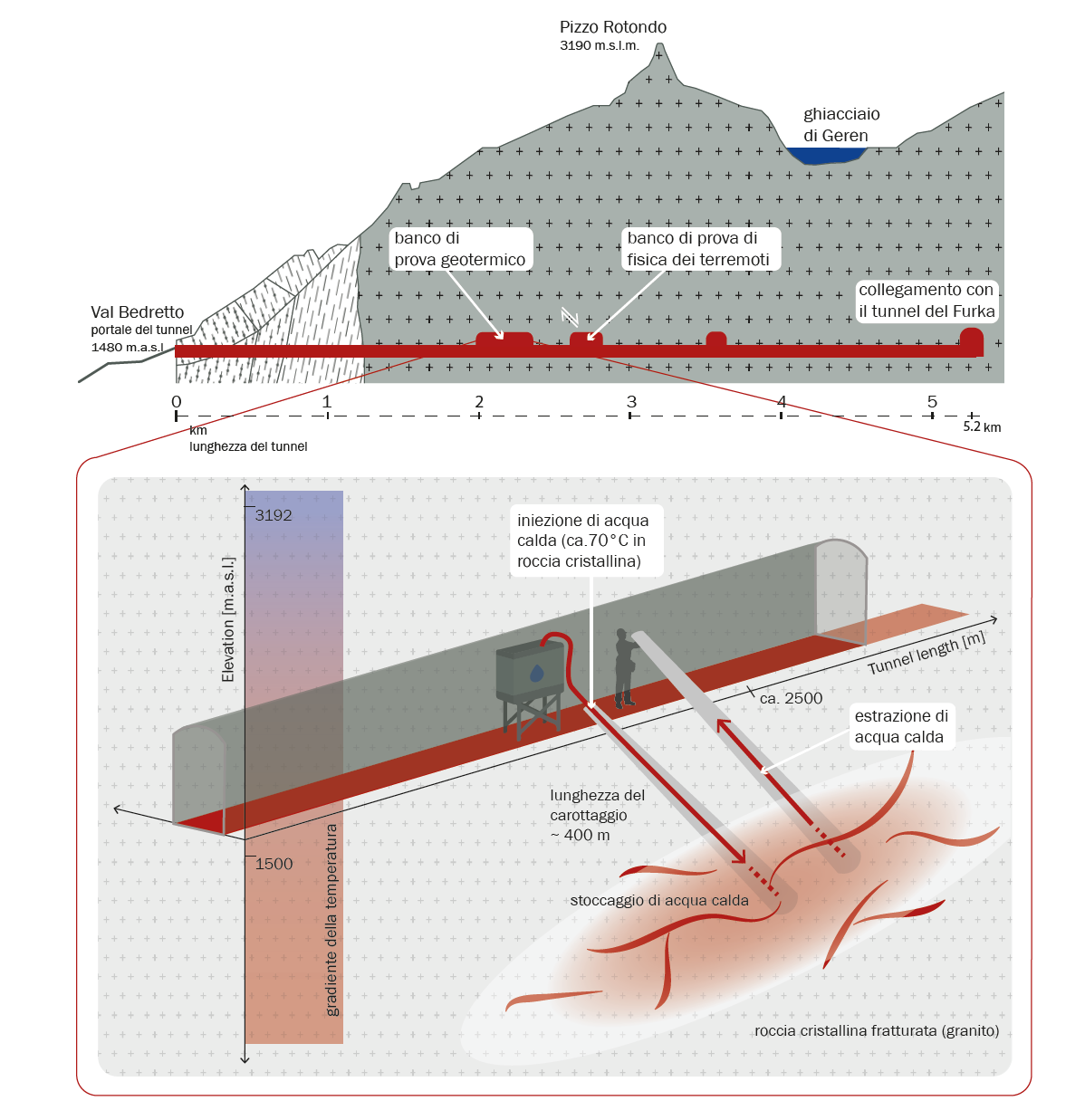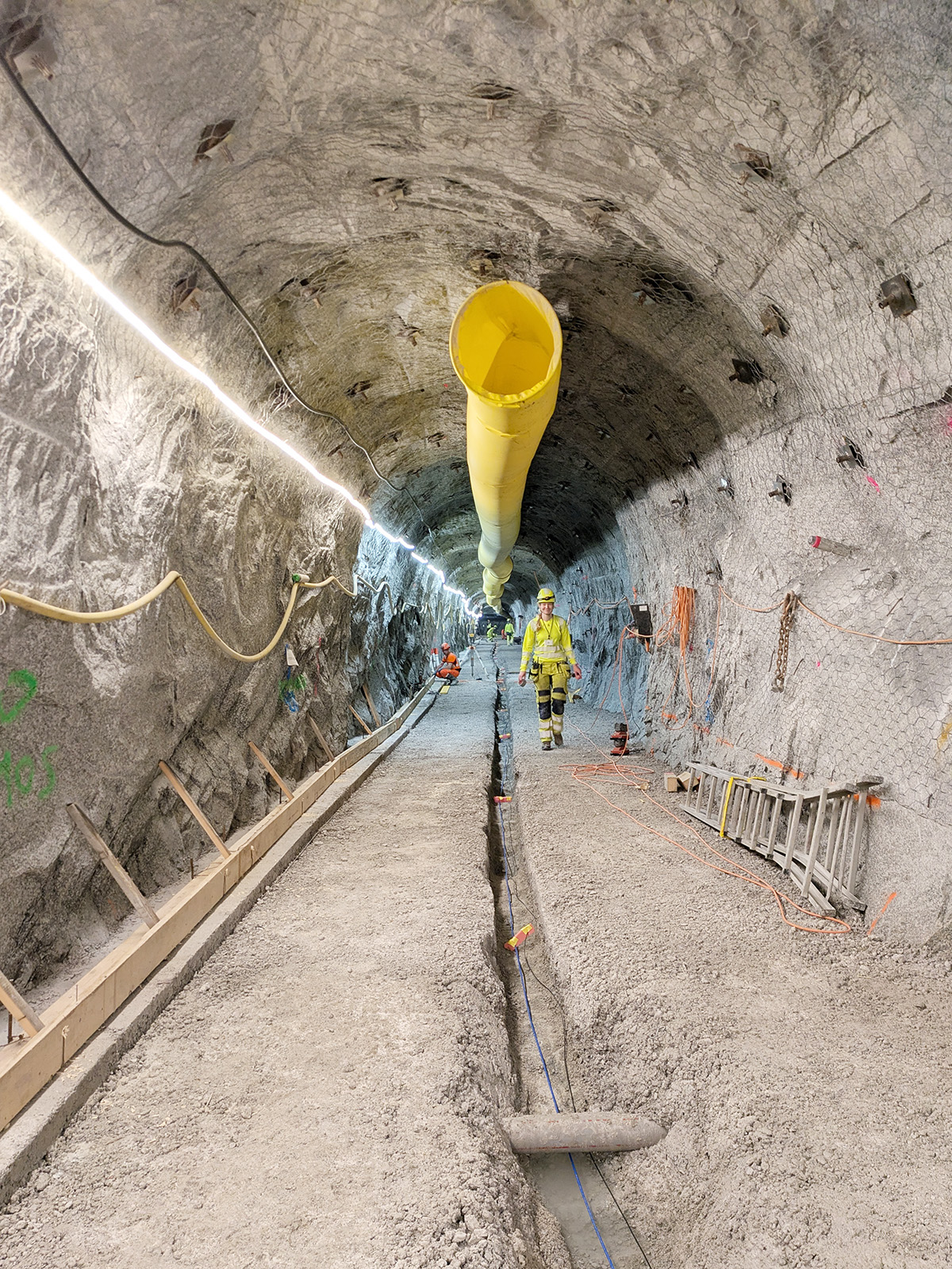2025-06-04
New experiment on heat storage in rock launched
The BEACH (Bedretto Energy Storage and Circulation of Geothermal Energy) pilot and demonstration project is investigating the feasibility of heat storage in crystalline bedrock, i.e. granite, for the first time. An initial injection test lasting several days began this week..
The concept being investigated in BEACH is already established in sedimentary rocks and commercially available. Larger buildings, such as the German Bundestag building, use such underground storage facilities for heating in winter. By combining several boreholes, the system can also be used for cooling in summer. The predominant bedrock in Switzerland, which makes up about 60% of the country's surface area, consists of crystalline rock. Unlike sedimentary rock, it lacks the pore space that provides the storage effect. However, the opportunity offered by crystalline rock lies in the fine fissures that could be used to store water and heat.
Such a process has not yet been tested in this type of rock. In preparation, researchers have already created numerical models based on data collected in previous experiments at the BedrettoLab on rock volume. In the now running test, water is being injected into the borehole to heat it in the surrounding rock. Initially, the water will remain in the rock for only a few days, but in further experiments within the BEACH project, it will be left for longer periods, and warm water will also be injected to test heat storage.
Storing heat in rock
In a real-life project, excess heat in summer, e.g. from solar energy, would be used to heat water, which would then be stored in deep rock. Depths of around 1.5 km are planned, where the average temperature is around 60 °C. Depending on the flow velocity underground, the location of a second borehole will be determined in order to bring the warm water back to the earth's surface for use.
The BedrettoLab comes close to these real conditions, as the geothermal laboratory is covered by about one kilometre of rock and the rock has a suitable fracture system. ‘We are exploiting existing fractures and the fluids circulating in them and enriching the existing fracture structures with more water,’ explains project manager Maren Brehme. Many important parameters are already known from the rock volume in the BedrettoLab. For example, it is to be expected that a certain amount of water will flow away and not follow the main flow direction exclusively. However, it is important for the feasibility of the project to find out whether at least a large part of the injected water volume can be extracted again.
In addition to the ongoing test in the BedrettoLab, the BEACH project team is already in talks with an industrial company in Schaffhausen that has expressed interest in working with the BEACH researchers to implement the concept tested in the BedrettoLab in a pilot plant.
To learn more about BEACH, you can watch the following TV report (in German): 10vor10 (SRF) from August 2, 2024
2025-05-22
When tunnel construction drives research
In September 2023, construction work began on a new side tunnel as part of the FEAR project. This tunnel runs parallel to a natural fault zone, which will be examined at close range to better understand how earthquakes evolve and stop. The excavation work also supported another research project—PRECODE—focusing on the behavior of crystalline rocks as a geological barrier for the disposal of nuclear waste. The goal of this project is to investigate how the surrounding rock responds to excavation activities, particularly in terms of stability, and how the Excavation Damage Zone (EDZ)—meaning the tunnel walls and surrounding rock volume directly affected by the excavation—evolves over time. The EDZ is a crucial factor in the search for a suitable nuclear waste repository.
To investigate PRECODE’s research questions, the rock volume to be excavated was extensively instrumented beforehand using various monitoring techniques, including seismic, hydraulic, deformation, and geophysical methods. One important research question is the impact of excavation methods on the EDZ, including a comparison of two techniques. The objective is to observe the evolution of the EDZ over a period of three to five years.
The first ten meters of the new tunnel were excavated using controlled blasting, while the remaining eleven meters were excavated using a technique known as “Line Drilling and Rock Breaking,” internally referred to as “Soft Excavation.” This method involved drilling numerous small holes around the tunnel perimeter to serve as anchoring points for a rock splitter, which was then used to break up the interior material. The objective of the Soft Excavation was to minimize excavation-induced damage, allowing the project to assess damage development driven purely by stress redistribution, in contrast to construction-induced damage caused by drill and blast.
Initial results clearly demonstrate the development of the EDZ around the tunnel in response to excavation. Identifying the characteristics of this short-term EDZ—particularly its location and extent—paved the way for the PRECODE research team to focus on the area of interest for long-term monitoring, where they will study how the damage evolves over time due to changing environmental conditions.
After this test section, excavation continued for another approximately 80 meters using the faster drill-and-blast method. As of the end of April, excavation of the side tunnel has been completed. Final tasks are now underway, including paving the tunnel floor with concrete and installing a metal mesh on the ceiling to ensure a safe working environment. This month, the drilling of the first boreholes from the new side tunnel is planned to continue the research efforts.
The PRECODE project is led by a research team at RWTH Aachen. Project partners are ETH Zurich, York University (Canada), Dalhousie University (Canada), and BGE Technology GmbH (Germany).
2025-03-06
Public Guided Tours at BedrettoLab 2025
In cooperation with the Museum Sasso San Gottardo, ETH Zurich will once again offer public guided tours at BedrettoLab starting in summer 2025. The tours will take place on five dates and will be held in Italian and German.
The BedrettoLab, situated in a 5.2 km-long rock tunnel, offers a unique opportunity to study the geology of the Alps and visit a one-of-a-kind underground laboratory operated by ETH Zurich. In collaboration with the Museum Sasso San Gottardo, visitors will have the opportunity to explore the BedrettoLab on five occasions, guided by trained tour guides.
During the approximately two-hour walking tour, visitors will learn about the history of the Bedretto tunnel. They will also discover geological phenomena visible on the tunnel’s unlined walls, offering a tangible experience of the Alps' formation. Additionally, they will visit the geothermal testbed and gain insight into why ETH Zurich has chosen this unique location for geothermal and earthquake research.
Costs and ticket booking
The cost per person for a tour is CHF 25. Tickets for the following dates can be booked on the Museum Sasso San Gottardo website: www.sasso-sangottardo.ch/bedrettolab.
- Saturday, June 14
- Sunday, July 13
- Friday, August 8 (tours on this day in German only)
- Saturday, September 20
- Saturday, October 11
More information on guided tours: www.bedrettolab.ethz.ch/en/about/visit/
2025-02-20
Final construction phase of the new side tunnel has begun

The final construction phase of the new side tunnel has recently started. About 60 meters still need to be built using drill-and-blast excavation to complete the 120-meter-long tunnel. The side tunnel is expected to be completed in the fall.
2025-01-30
Successful injection experiment at the new Earthquake Physics Testbed of the BedrettoLab
A three week long injection experiment at the new Earthquake Physics Testbed of the BedrettoLab was successfully completed in November and December 2024. The goal was to characterise how the target fault structure of the FEAR (Fault Activation and Earthquake Rupture) project responds to high-pressure water injection. The results will serve as a baseline for a series of experiments planned in the coming two years, which are aimed at understanding fault zone deformation processes.
After extensive preparation—including drilling boreholes, installing sensors, and manufacturing a specially designed fault deformation probe—the experiment commenced in late November. Over three weeks, approximately 1’100 cubic metres of water were injected into the target fault zone via two boreholes, using a custom designed remote control system. This volume is roughly equivalent to 5’600 bathtubs of water. Importantly, all water used was sourced from wells in the tunnel, ensuring no drinking water was wasted.
The injection was expected to induce a response in the fault structure due to increased pressure in the surrounding rock. Initial analysis indicates minor fault movements, with detailed calculations underway to determine the extent of this displacement. Additionally, the experiment revealed greater complexity in the fault zone than previously assumed. During high-pressure injection, small seismic events occurred more than 50 meters away from the injection site, and suggest the presence of an extensive fracture network.
These findings confirm that the fault zone can be activated, and provide crucial information for the design of the next FEAR experiments, which will focus on the controlled activation of specific fault zone segments.




